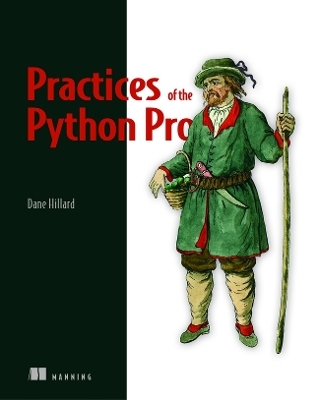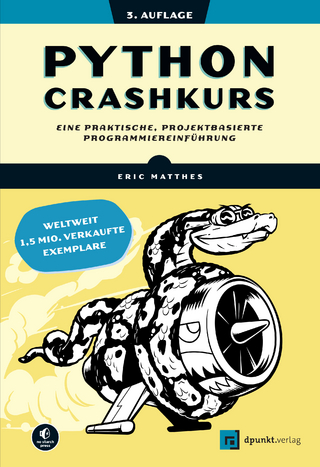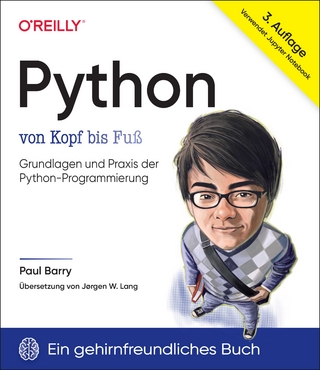
Practices of the Python Pro
Seiten
2020
Manning Publications (Verlag)
978-1-61729-608-6 (ISBN)
Manning Publications (Verlag)
978-1-61729-608-6 (ISBN)
Summary
Professional developers know the many benefits of writing application code that's clean, well-organized, and easy to maintain. By learning and following established patterns and best practices, you can take your code and your career to a new level.
With Practices of the Python Pro, you'll learn to design professional-level, clean, easily maintainable software at scale using the incredibly popular programming language, Python. You'll find easy-to-grok examples that use pseudocode and Python to introduce software development best practices, along with dozens of instantly useful techniques that will help you code like a pro. Purchase of the print book includes a free eBook in PDF, Kindle, and ePub formats from Manning Publications.
About the technology
Professional-quality code does more than just run without bugs. It's clean, readable, and easy to maintain. To step up from a capable Python coder to a professional developer, you need to learn industry standards for coding style, application design, and development process. That's where this book is indispensable.
About the book
Practices of the Python Pro teaches you to design and write professional-quality software that's understandable, maintainable, and extensible. Dane Hillard is a Python pro who has helped many dozens of developers make this step, and he knows what it takes. With helpful examples and exercises, he teaches you when, why, and how to modularize your code, how to improve quality by reducing complexity, and much more. Embrace these core principles, and your code will become easier for you and others to read, maintain, and reuse.
What's inside
Organizing large Python projects
Achieving the right levels of abstraction
Writing clean, reusable code Inheritance and composition
Considerations for testing and performance
About the reader
For readers familiar with the basics of Python, or another OO language.
About the author
Dane Hillard has spent the majority of his development career using Python to build web applications.
Table of Contents:
PART 1 WHY IT ALL MATTERS
1 ] The bigger picture
PART 2 FOUNDATIONS OF DESIGN
2 ] Separation of concerns
3 ] Abstraction and encapsulation
4 ] Designing for high performance
5 ] Testing your software
PART 3 NAILING DOWN LARGE SYSTEMS
6 ] Separation of concerns in practice
7 ] Extensibility and flexibility
8 ] The rules (and exceptions) of inheritance
9 ] Keeping things lightweight
10 ] Achieving loose coupling
PART 4 WHAT'S NEXT?
11 ] Onward and upward
Professional developers know the many benefits of writing application code that's clean, well-organized, and easy to maintain. By learning and following established patterns and best practices, you can take your code and your career to a new level.
With Practices of the Python Pro, you'll learn to design professional-level, clean, easily maintainable software at scale using the incredibly popular programming language, Python. You'll find easy-to-grok examples that use pseudocode and Python to introduce software development best practices, along with dozens of instantly useful techniques that will help you code like a pro. Purchase of the print book includes a free eBook in PDF, Kindle, and ePub formats from Manning Publications.
About the technology
Professional-quality code does more than just run without bugs. It's clean, readable, and easy to maintain. To step up from a capable Python coder to a professional developer, you need to learn industry standards for coding style, application design, and development process. That's where this book is indispensable.
About the book
Practices of the Python Pro teaches you to design and write professional-quality software that's understandable, maintainable, and extensible. Dane Hillard is a Python pro who has helped many dozens of developers make this step, and he knows what it takes. With helpful examples and exercises, he teaches you when, why, and how to modularize your code, how to improve quality by reducing complexity, and much more. Embrace these core principles, and your code will become easier for you and others to read, maintain, and reuse.
What's inside
Organizing large Python projects
Achieving the right levels of abstraction
Writing clean, reusable code Inheritance and composition
Considerations for testing and performance
About the reader
For readers familiar with the basics of Python, or another OO language.
About the author
Dane Hillard has spent the majority of his development career using Python to build web applications.
Table of Contents:
PART 1 WHY IT ALL MATTERS
1 ] The bigger picture
PART 2 FOUNDATIONS OF DESIGN
2 ] Separation of concerns
3 ] Abstraction and encapsulation
4 ] Designing for high performance
5 ] Testing your software
PART 3 NAILING DOWN LARGE SYSTEMS
6 ] Separation of concerns in practice
7 ] Extensibility and flexibility
8 ] The rules (and exceptions) of inheritance
9 ] Keeping things lightweight
10 ] Achieving loose coupling
PART 4 WHAT'S NEXT?
11 ] Onward and upward
Dane Hillard has spent the majority of professional software development career building web applications using Python. He’s passionate about introducing professional software development techniques to the many data scientists, business pros, and other self-taught programmers working with Python.
| Erscheinungsdatum | 31.12.2019 |
|---|---|
| Zusatzinfo | Illustrations |
| Verlagsort | New York |
| Sprache | englisch |
| Maße | 188 x 234 mm |
| Gewicht | 420 g |
| Themenwelt | Informatik ► Programmiersprachen / -werkzeuge ► Python |
| ISBN-10 | 1-61729-608-2 / 1617296082 |
| ISBN-13 | 978-1-61729-608-6 / 9781617296086 |
| Zustand | Neuware |
| Haben Sie eine Frage zum Produkt? |
Mehr entdecken
aus dem Bereich
aus dem Bereich
eine praktische, projektbasierte Programmiereinführung
Buch | Softcover (2023)
dpunkt (Verlag)
32,90 €
Grundlagen und Praxis der Python-Programmierung
Buch | Softcover (2024)
O'Reilly (Verlag)
49,90 €


